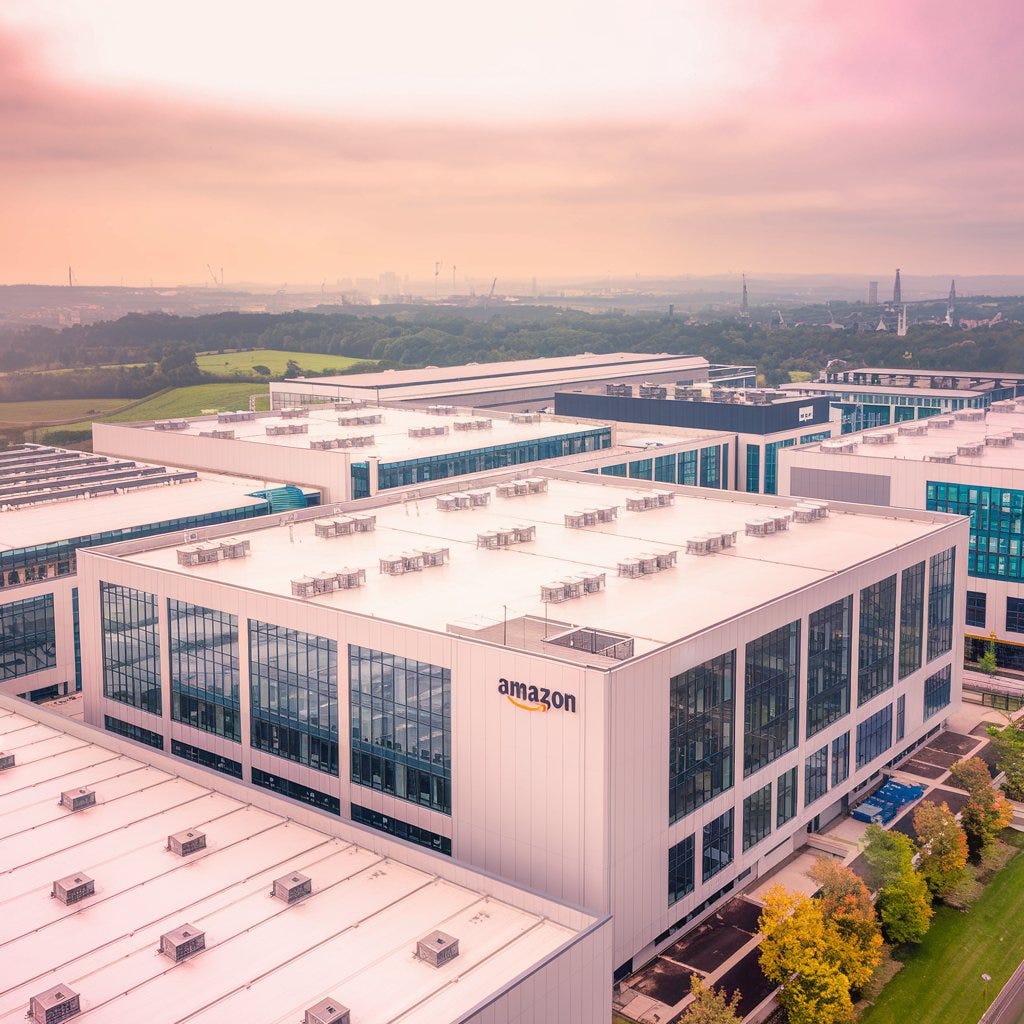Is Amazon Building Britain’s AI Future or Taking It Over?
A deep dive into Amazon’s £40B UK investment and why the future of AI infrastructure may come at the cost of national sovereignty.
Welcome to Global Data Center Hub. Join 1500+ investors, operators, and innovators reading to stay ahead of the latest trends in the data center sector in developed and emerging markets globally.
On June 24, 2025, Amazon announced a £40 billion investment in the United Kingdom, one of the largest foreign investments in UK history.
It was framed as a moment of national triumph. Jobs. GDP growth. AI innovation. A clean, hopeful story in an uncertain economic climate.
But here’s what the headlines didn’t tell you.
This investment isn’t just about data centers, fulfilment warehouses, or film studios. It’s about strategic leverage using infrastructure as influence.
A Closer Look at the Numbers
Amazon’s £40 billion commitment spans three years. It includes:
New fulfilment centers in Hull, Northampton, and the East Midlands
Expansion of its corporate HQ in East London
The redevelopment of Bray Film Studios
£8 billion (previously announced) for AWS data centers through 2028
But that £40B headline number? It’s a bundle
It includes previously committed infrastructure spending, operational costs like salaries and training, and public-sector contracts that were already in place. In essence, Amazon repackaged existing commitments and ongoing expenditures under a single number to maximize media and political impact.
The Real Strategic Play: AWS and AI Infrastructure
The heart of this story is not warehouses. It’s data centers and what they enable.
AWS already provides core digital infrastructure for UK public services. With this investment, it’s not just expanding compute capacity; it’s becoming an embedded layer in the country’s AI future.
The £8 billion AWS spend will fund high-density, AI-optimized data centers across the UK. These aren’t basic cloud warehouses, they’re the backbone of everything from enterprise analytics to public health models to machine learning for national security.
The UK is effectively outsourcing its AI infrastructure to a single foreign vendor.
And that has consequences.
The Grid Can’t Keep Up
Power is the silent constraint behind the AI gold rush. And Britain’s energy infrastructure is not ready.
Amazon’s Bedfordshire facility alone will consume 114.8 million kWh annually enough to power over 42,000 homes. The UK grid, already stressed, is now facing 500–600% increases in demand from data centers over the next decade.
Even AWS CEO Matt Garman recently admitted that “the UK will need more nuclear” to support the AI era.
Translation: without major public infrastructure investment, Amazon’s private ambitions don’t scale.
Environmental Sustainability or Greenwashing?
Amazon proudly touts that it met its 100% renewable energy goal in 2023. It has built 500+ solar and wind projects. It uses low-carbon concrete and advanced cooling.
And yet, every AWS facility still requires diesel backup generators.
Environmental activists in Bedfordshire have raised alarms about noise pollution, carbon emissions, and strain on water resources. Others warn that Amazon’s global push to meet AI demand could quietly erase any gains made in its sustainability narrative.
So, which is it: corporate green leadership or PR gloss on exponential energy consumption?
Jobs, GDP, and Political Immunity
Amazon estimates this £40 billion investment will contribute £38 billion to UK GDP by 2027 and support 14,000 full-time-equivalent jobs annually in the data center supply chain alone.
Politically, that makes it radioactive.
Any regulator looking to crack down on AWS’s market dominance now faces a stark tradeoff: enforce competition or jeopardize jobs, training programs, and regional investment.
In regions like Hull and Northampton, Amazon isn’t just creating jobs. It’s embedding itself as a key pillar of local economies locking in political capital and creating future barriers to resistance.
That’s not just economic development. That’s soft power.
Meanwhile, Regulation Heats Up
Behind the scenes, Amazon faces:
A £1 billion lawsuit from UK retailers over alleged misuse of marketplace data
A formal Competition and Markets Authority (CMA) probe into cloud market dominance
A government investigation into late payments to suppliers
An uncertain post-Brexit data adequacy regime with the EU
Yet the timing of this investment couldn’t be more convenient. Announced days after the launch of the Labour government’s “Modern Industrial Strategy,” Amazon has positioned itself as an indispensable partner in national revival.
It’s a playbook we’ve seen before: bundle influence, pre-empt regulation, and shape public perception before critics can mobilize.
What Happens When One Company Owns the Infrastructure of Intelligence?
There’s no question that Amazon’s presence brings real benefits: jobs, digital infrastructure, AI capacity.
But we must ask: at what cost?
What happens if AWS goes down or leaves?
What happens if the regulatory tide turns in Brussels or Washington?
What happens if foreign policy conflicts threaten data flows or sovereignty?
When a single entity controls the pipes of the AI era, the implications go far beyond pricing or service levels. It’s about national security, economic resilience, and long-term strategic autonomy.
Final Thought
This is not a story of good or bad. It’s a story of power.
Amazon’s £40B investment may indeed help build Britain’s AI future.
But we’d be naïve to think it doesn’t also give them increasing control over it.
The question isn’t whether the UK should welcome foreign investment.
The question is: how do you build an AI-powered economy without ceding sovereignty to those who own the infrastructure?
The answer starts by recognizing that compute is not neutral and cloud dominance isn’t just a tech issue.
It’s a matter of national strategy.



